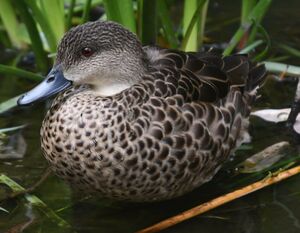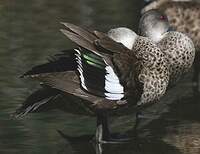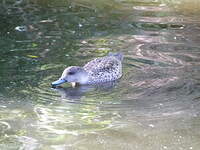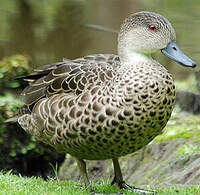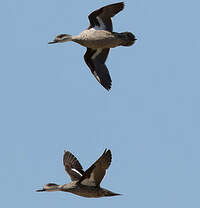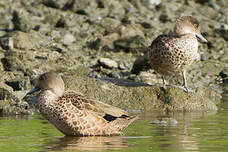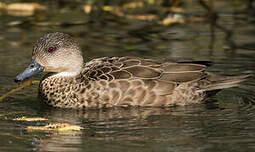Grey Teal
Anas gracilis - Sarcelle australasienne
Identification
This species is often considered a subspecies of Grey Teal (Anas gibberifrons). It does not present any sexual dimorphism. It is a small surface duck with a fairly light brown plumage with very pale cheeks, lower forehead, and front of the neck. The crown and back are a little darker brown than the sides. The eye is red and the bill is pale grey. The juveniles are similar, but paler and their eye is brown.
In flight, these birds present almost black wings with green reflections, a narrow white line in the back, and a wide white (triangular) band in the front. The undersides are white.
In Australia, the Grey Teal can be confused with a female Chestnut Teal (Anas castanea), but this last one does not have the cheeks and neck as pale and does not present any pale zone above the bill. In flight, the distinction is really not easy.
Subspecific information 2 subspecies
- Anas gracilis gracilis (New Guinea to Australia, New Caledonia and New Zealand)
- Anas gracilis remissa (Rennell I.. Solomon Islands.)
Foreign names
- Sarcelle australasienne,
- Cerceta gris,
- marrequinha-cinzenta,
- Australente,
- szürke réce,
- Australische Taling,
- Alzavola grigia,
- gråkricka,
- Nomadeand,
- kačica svetlobradá,
- čírka bělohrdlá,
- Australsk Grå Krikand,
- australiansuomutavi,
- xarxet gris,
- cyraneczka australijska,
- Серый чирок,
- Itik kelabu,
- ハイイロコガモ,
- 灰鸭,
- 灰鴨,
Voice song and call
Habitat
Behaviour character trait
The species is quite gregarious. Individuals from New Zealand are rather sedentary. It was a rare bird in this latter country before the great drought that struck Australia in 1957 and 1958, years which saw a great number of these birds leave Australia and, for some of them reach New Zealand and settle in there; the Grey Teal has been common since then, aided by the installation of nesting boxes.
Dietfeeding habits
Reproduction nesting
The Grey Teal breeds mainly from July to December (from June to February in New Zealand), but, in southern Australia, it can do so year-round if aquatic conditions are satisfactory.
Rarely seen in ducks of the Anas genus, this Teal often builds its nest in cavities in trees; sometimes in a depression on the ground. The nest itself is made from materials gathered on-site. Clutches are, on average, 7 or 8 eggs, but it is known for several females to lay in the same nest, with a record clutch of 30 eggs having been found. Incubation, done solely by the female, takes just under a month, and the young can fly at around two months old.Geographic range
The Grey Teal is found in Papua New Guinea, is widespread in the plains of New Zealand and can be seen all across Australia; however, on this continent, it is only sporadic in the driest areas, settling there only after rain events. It is also present in Indonesia, New Caledonia and a few other archipelagos.
Threats - protection
IUCN conservation status
concern
in the Wild
threatened
evaluated
The Grey Teal is not endangered, though it suffers from intensive hunting and a small decline. Australian populations are around 2 million individuals and those in New Zealand about 100,000. The endemic subspecies of Rennell Island (remissa) is extinct whereas populations of the Cocos and Andaman Islands are currently in the range of 500-1000 individuals. This species hybridizes with Chestnut Teal and the Cape Shoveler (Anas superciliosa).
Sources of information
- IOC World Bird List (v15.1), Gill, F and D Donsker (Eds). 2025-12-07.
- The hand guide to the birds of New Zealand, Robertson Hugh et Heather Barrie
- Vol. 1 - Handbook of the Birds of the World, Josep del Hoyo-Andrew Elliot-Jordi Sargatal
- Guide des canards, des oies et des cygnes, Steve Madge
- Avibase, Lepage Denis
- The Field Guide to the Birds of Australia, Graham Pizzey et Frank Knight
- Waterbird Population Estimates, Simon Delany Derek Scott
Other sources of interest
 Specification sheet created on
01/08/2023 by Georges Olioso
Specification sheet created on
01/08/2023 by Georges OliosoTranslation by AI Oiseaux.net
© 1996-2025 Oiseaux.net
- Accipitriformes
- Aegotheliformes
- Anseriformes
- Apodiformes
- Apterygiformes
- Bucerotiformes
- Caprimulgiformes
- Cariamiformes
- Casuariiformes
- Charadriiformes
- Ciconiiformes
- Coliiformes
- Columbiformes
- Coraciiformes
- Cuculiformes
- Eurypygiformes
- Falconiformes
- Galliformes
- Gaviiformes
- Gruiformes
- Leptosomiformes
- Mesitornithiformes
- Musophagiformes
- Nyctibiiformes
- Opisthocomiformes
- Otidiformes
- Passeriformes
- Pelecaniformes
- Phaethontiformes
- Phoenicopteriformes
- Piciformes
- Podargiformes
- Podicipediformes
- Procellariiformes
- Psittaciformes
- Pterocliformes
- Rheiformes
- Sphenisciformes
- Steatornithiformes
- Strigiformes
- Struthioniformes
- Suliformes
- Tinamiformes
- Trogoniformes

